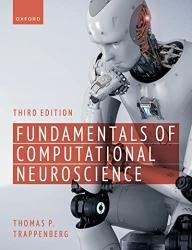Fundamentals of Computational Neuroscience, 3rd Edition
- Добавил: literator
- Дата: 30-11-2022, 17:55
- Комментариев: 0
 Название: Fundamentals of Computational Neuroscience, 3rd Edition
Название: Fundamentals of Computational Neuroscience, 3rd EditionАвтор: Thomas Trappenberg
Издательство: Oxford University Press
Год: 2023
Страниц: 411
Язык: английский
Формат: pdf (true)
Размер: 35.9 MB
Computational neuroscience is still a young and dynamically developing discipline, and some choice of topics and presentation style had to be made. This text introduces some fundamental concepts, with an emphasis on basic neuronal models and network properties. In contrast to the common research literature, this book is trying to paint the larger picture and tries to emphasize some of the concepts and assumptions for simplifications used in the scientific technique of modelling. Computational neuroscience and Artificial Intelligence (AI) are close cousins. Computational models of neural systems such as models of neurons are much older, but connecting learning and cognitive systems created excitement over the possibility to better understand mind. The invention of learning machines has revolutionized many applications as recently seen in the dramatic progress of machine vision and natural language processing (NLP) through Deep Learning. While there has been much recent progress in Machine Learning, researchers in this area often wonder how the brain works. It sometimes seems that scientific progress oscillates between computational neuroscience and Machine Learning.
Computational neuroscience is the theoretical study of the brain to uncover the principles and mechanisms that guide the development, organization, information processing, and mental functions of the nervous system. Although not a new area, it is only recently that enough knowledge has been gathered to establish computational neuroscience as a scientific discipline in its own right. Given the complexity of the field, and its increasing importance in progressing our understanding of how the brain works, there has long been a need for an introductory text on what is often assumed to be an impenetrable topic.
The new edition of Fundamentals of Computational Neuroscience build on the success and strengths of the previous editions. It introduces the theoretical foundations of neuroscience with a focus on the nature of information processing in the brain. The book covers the introduction and motivation of simplified models of neurons that are suitable for exploring information processing in large brain-like networks. Additionally, it introduces several fundamental network architectures and discusses their relevance for information processing in the brain, giving some examples of models of higher-order cognitive functions to demonstrate the advanced insight that can be gained with such studies.
Each chapter starts by introducing its topic with experimental facts and conceptual questions related to the study of brain function. An additional feature is the inclusion of simple MATLAB programs that can be used to explore many of the mechanisms explained in the book. The programs in this book are now provided in Python to improve accessibility and due to Python’s increasing importance in Machine Learning and Data Science. While it was challenging to balance a scientist’s approach of making minimalist and clean examples with common programming approaches, I hope that I found some balance. Comments in programs are often a good idea in complex software packages.
Chapter 1 provides a high-level overview and some fundamental questions about brain theories, a brief discussion about the role of modelling, and some basic neuroscience facts that are useful to keep in mind for later use. We also review the essential scientific programming in Python and the basic mathematical and statistical concept used in the book. Chapters 2–4 focus on basic mechanisms and modelling of single neurons or population averages. This starts from a fairly detailed discussion of changes in the membrane potentials through ion channels, spike generations, and synaptic plasticity, with increasingly abstractions in the following chapters. Chapters 5–7 describe the information-processing capabilities of basic networks, including feedforward and competitive recurrent networks. The last part of the book describes some examples of combining such elementary networks as well as some examples of more system-level models of the brain.
Скачать Fundamentals of Computational Neuroscience, 3rd Edition
[related-news] [/related-news]
Внимание
Уважаемый посетитель, Вы зашли на сайт как незарегистрированный пользователь.
Мы рекомендуем Вам зарегистрироваться либо войти на сайт под своим именем.
Уважаемый посетитель, Вы зашли на сайт как незарегистрированный пользователь.
Мы рекомендуем Вам зарегистрироваться либо войти на сайт под своим именем.
